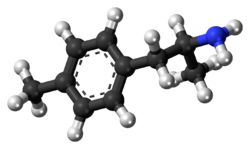Chemistry:4-Methylamphetamine
 | |
 | |
| Clinical data | |
|---|---|
| Routes of administration | Oral, intranasal, injection, |
| ATC code |
|
| Legal status | |
| Legal status |
|
| Pharmacokinetic data | |
| Elimination half-life | 6-12 hours |
| Excretion | Urine |
| Identifiers | |
| |
| CAS Number | |
| PubChem CID | |
| ChemSpider | |
| UNII | |
| ChEMBL | |
| Chemical and physical data | |
| Formula | C10H15N |
| Molar mass | 149.237 g·mol−1 |
| 3D model (JSmol) | |
| |
| |
| | |
4-Methylamphetamine (4-MA; PAL-313; Aptrol; p-TAP) is a stimulant and anorectic drug of the phenethylamine and amphetamine chemical classes.
In vitro, it acts as a potent and balanced serotonin, norepinephrine, and dopamine releasing agent with Ki affinity values of 53.4nM, 22.2nM, and 44.1nM at the serotonin, norepinephrine, and dopamine transporters, respectively.[1] However, more recent in vivo studies that involved performing microdialysis on rats showed a different trend. These studies showed that 4-methylamphetamine is much more potent at elevating serotonin (~18 x baseline) relative to dopamine (~5 x baseline). The authors speculated that this is because 5-HT release dampens DA release through some mechanism. For example, it was suggested that a possible cause for this could be activation of 5HT2C receptors since this is known to inhibit DA release. In addition there are alternative explanations such as 5-HT release then going on to encourage GABA release, which has an inhibitory effect on DA neurons.[2]
4-MA was investigated as an appetite suppressant in 1952 and was even given a trade name, Aptrol, but development was apparently never completed.[3] More recently it has been reported as a novel designer drug.
In animal studies, 4-MA was shown to have the lowest rate of self-administration out of a range of similar drugs tested (the others being 3-methylamphetamine, 4-fluoroamphetamine, and 3-fluoroamphetamine), likely as a result of having the highest potency for releasing serotonin relative to dopamine.[4][5]
More than a dozen deaths were reported throughout Europe in 2012-2013 after consumption of amphetamine ('speed') contaminated with 4-methylamphetamine.[6]
See also
- 1-(4-Methylphenyl)-2-aminobutane
- 2-Methylamphetamine
- 3-Methylamphetamine
- 4-Methyl-N-methylamphetamine
- 4-Methyl-N-methylcathinone
- 4-Methylphenmetrazine
- 3-Methoxy-4-methylamphetamine
- 3,4-Dimethylamphetamine
- 4-Ethylamphetamine
References
- ↑ "Relationship between the serotonergic activity and reinforcing effects of a series of amphetamine analogs". The Journal of Pharmacology and Experimental Therapeutics 313 (2): 848–54. May 2005. doi:10.1124/jpet.104.080101. PMID 15677348.
- ↑ "Role of serotonin in central dopamine dysfunction". CNS Neuroscience & Therapeutics 16 (3): 179–94. June 2010. doi:10.1111/j.1755-5949.2010.00135.x. PMID 20557570. PMC 6493878. https://iris.unipa.it/bitstream/10447/60783/1/Di%20Giovanni%20et%20al.%2c%202010%20%20CNS%20Neurosci%26Ther.pdf.
- ↑ "2-Amino-1-(p-methylphenyl)-propane (aptrol) as an anorexigenic agent in weight reduction". New York State Journal of Medicine 52 (2): 223–6. January 1952. PMID 14890975.
- ↑ "Relationship between the serotonergic activity and reinforcing effects of a series of amphetamine analogs". The Journal of Pharmacology and Experimental Therapeutics 313 (2): 848–54. May 2005. doi:10.1124/jpet.104.080101. PMID 15677348.
- ↑ "In vivo effects of amphetamine analogs reveal evidence for serotonergic inhibition of mesolimbic dopamine transmission in the rat". The Journal of Pharmacology and Experimental Therapeutics 337 (1): 218–25. April 2011. doi:10.1124/jpet.110.176271. PMID 21228061.
- ↑ "4-Methyl-amphetamine: a health threat for recreational amphetamine users". Journal of Psychopharmacology 27 (9): 817–22. September 2013. doi:10.1177/0269881113487950. PMID 23784740.
 |

